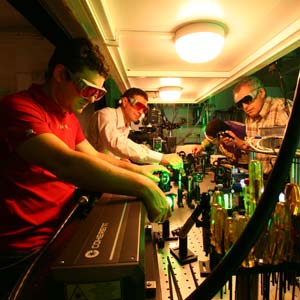חוקרי הטכניון הצליחו לראשונה לצפות בהשפעת "סחרור" (ספין) של פוטונים על מסלול התקדמותם ובכך פתחו תחום מחקר חדש – ספינאופטיקה, ומצאו דרך חדשה לשליטה באור באמצעות סיחרורו

פרופ' ארז חסמן במעבדה
חוקרי הטכניון הם הראשונים שהצליחו לצפות באפקט מגנוס באור, ובכך פתחו דרך חדשה לשליטה באור בקנה מידה ננומטרי בעזרת "סחרור" של האור. התגלית הניסויית החדשה מספקת דרך טובה להבנה פיסיקלית בסיסית למסלולם של חלקיקים מסתובבים הנעים בתווך לא הומוגני, שעד כה ניתן היה לצפות רק במערכות מסובכות של חומר מעובה. המחקר התפרסם בכתב העת המדעי Nature Photonics בגיליון דצמבר ובוצע על ידי פרופסור ארז חסמן, ד"ר קונסטנטין בליאוך, ד"ר ולדימיר קליינר ואבי ניב מהמעבדה למיקרו וננו-אופטיקה, הפקולטה להנדסת מכונות ומכון ראסל ברי למחקר בננו-טכנולוגיה.
יצירתו של כוח צדי על מוצק גלילי או כדורי מסתובב השקוע בנוזל (או גז) כשיש תנועה יחסית בין הגוף המסתובב לנוזל – קרויה אפקט מגנוס (Magnus effect). הפיסיקאי הגרמני היינריך מגנוס תיאר לראשונה את האפקט ב-1853. במשחקי כדור רבים אחראי אפקט מגנוס לתנועת המסלול של כדור מסתובב (למשל, שחקן כדורגל, טניס או פינג פונג אשר "מסובב" את הכדור). אפקט מגנוס משפיע גם על מסלולם של טילים מסתובבים, ומשפיע על תעופת כלי טייס מסוימים.
לגלים אלקטרומגנטיים המתנהגים גם כחלקיקים נטולי מסה הנקראים פוטונים, יש תכונה פנימית – "סחרור" של הפוטונים (ספין). הספין, שהוא התנע הזוויתי הפנימי של הפוטונים, תלוי בכיוון הקיטוב המעגלי של האור. חוקרי הטכניון מדווחים במאמרם על תיאוריה מאוחדת בנושא ולראשונה על תצפית ניסיונית ישירה בסטייה תלוית-ספין – אפקט מגנוס בפוטונים. אפקט מגנוס לאור (הנקרא גם spin Hall effect), גורם לאור לסטות בשל האינטראקציה בין הספין של הפוטונים לצורת מסלולו. ההשלכות האפשריות של עבודתם נרחבות מאוד. "יישום האפקט הזה באמצעים פוטוניים וננו-אופטיים עשוי להוביל לפיתוחו של תחום מחקר חדש – ספינאופטיקה", אומר פרופ' חסמן. "אנו מקווים כי נצליח לשלוט באור בקנה מידה ננומטרי, בדרכים שלא היו אפשריות עד כה".
החוקרים מאמינים כי בהמשך תספק עבודתם תוצאות שיועילו גם לתחומים אחרים בפיסיקה. לדברי פרופ' חסמן, "ישנן מערכות פיסיקליות רבות שבהן הספין של החלקיקים משפיע על מסלול התנועה, כגון בפיסיקה של אנרגיות גבוהות וחומר מעובה. האפקט דומה ברוב המקרים, אבל קשה מאוד לחקירה ניסיונית. הגישה הניסויית שלנו מאפשרת להתמודד עם שאלות בסיסיות אלו בבהירות ובדיוק".







